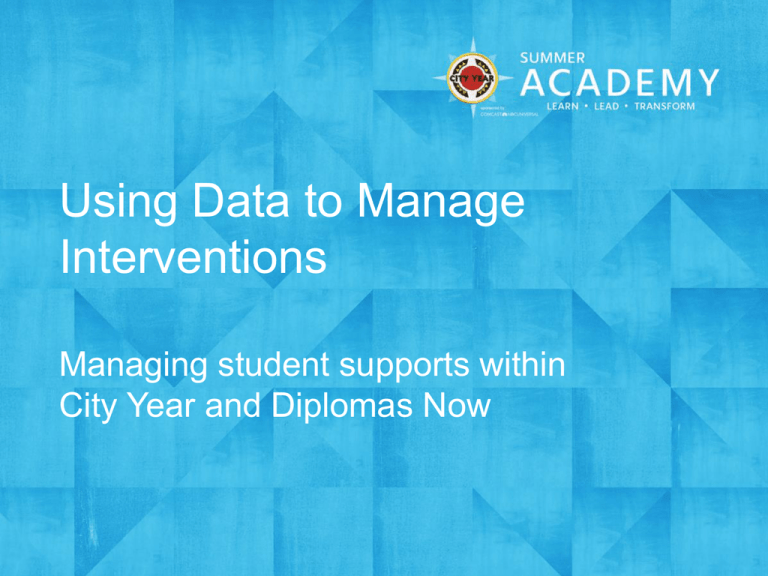Using Data to Manage Interventions – Powerpoint
advertisement

Using Data to Manage Interventions Managing student supports within City Year and Diplomas Now Do Now Fill out the chart provided with as many examples of relevant data that you or teams you work with might use in schools. Objectives At the end of this session participants will • Understand data context and terminology for Diplomas Now and City Year sites • Understand uses of data in school contexts Who We Are • Kellie Hinkle: Diplomas Now Manager of School Turnaround, CYHQ • Dan Anderson: Talent Development Facilitator at the Jeremiah E. Burke High School Agenda (90 minutes) • • • • • • • Do Now (5 minutes) Agenda (5 minutes) Data Review (20 minutes) Managing the Data (10 minutes) Data Sorting Activity (25 minutes) Q & A (15 minutes) Wrap Up and Evaluation (10) Data Review Data Review What examples of data did you come up with that would shed light on student patterns in Attendance, Behavior, and Coursework? Examples: Attendance • Student average daily attendance – Days missed, attended and excused – Sorted by student, homeroom, grade, etc. • Student tardy rates – How often are students late? – How late are they? • Logs of phone calls to students and families regarding attendance Examples: Behavior • Suspensions • Detentions • Referrals of students for behavior reasons to administrators, student support, etc • Behavior management/PBIS information • Results of student risk and character skills assessments such as Success Highways Examples: Coursework • Results of diagnostic assessments – DIBELS, GRADE, GMADE, ANet, Gates-MacGinitie – Assessments of skills in various areas, such as fluency, vocabulary, reading comprehension, etc • Course grades – Viewed by student, course, section, etc • Results of state test scores and predictive diagnostics • Results of teacher-designed formative and summative assessments DN 101: What Is an EWI? EWIs – early warning indicators • Indication of dropout risk • Research based ABCs – • (poor) Attendance, • (disruptive) Behavior, • Course performance (failure in English and/or math) Indicator Area Off-Track Sliding On-Track Attendance <85% ADA 85-90% ADA >90% ADA Behavior >0 suspensions Coursework (ELA and Math) Course grade of F 0 suspensions Course grade of D Course grade >D DN Goals DN goals – At least 67% of students in focus grades have no EWIs at the end of the school year – For each ABC: ≥50% of students with an EWI at any point move ontrack by the end of the year Off Track On Track Attendance: <90% average daily attendance ≥90% average daily attendance Behavior: 1 or more suspensions no suspensions ELA/Literacy: a “D” or an “F” ELA grade a “C” or higher ELA grade Math: a “D” or an “F” math grade a “C” or higher math grade Data Use for Diplomas Now There are a number of tools, processes and systems in which data is used in Diplomas Now: • DN focus list • DN quarterly reports • School-based data systems • EWI meetings DN Focus List A collaborative process: • the entire DN school team (and school faculty, if available) should work together to identify students For all students in need: • any student with an EWI should be on the focus list in the indicator area(s) in which they need help DN Quarterly Reports Early Warning Indicator Meetings Goal: To coordinate and create interventions for students who are exhibiting early warning indicators and to closely monitor their progress towards success. These meetings: • Are an opportunity for all the adults in a school that work with a particular set of students to come together to: analyze data craft interventions project manage existing interventions • Occur at least every other week for each adult team in the school Managing the Data Managing the Data Components – Compiling and utilizing data – Using the focus list – Holding EWI meetings Compiling and Utilizing Data 1. Determine what data you need to track 2. Determine how you need to use your data 3. Determine whether you will use a school- or district-provided data management system, or manage your own Example of Data Dashboard Core Course Grades Term 4 Hi s tory ESL A ESL B Gym Spa ni s h Art Tech Advi s ory JROTC #N/A #N/A #N/A #N/A #N/A #N/A #N/A #N/A #N/A #N/A #N/A #N/A #N/A #N/A #N/A #N/A #N/A #N/A #N/A #N/A #N/A #N/A #N/A #N/A #N/A #N/A #N/A #N/A #N/A #N/A #N/A #N/A #N/A #N/A #N/A #N/A #N/A #N/A #N/A #N/A #N/A #N/A #N/A B #N/A #N/A #N/A C+ #N/A #N/A #N/A C #N/A #N/A P #N/A #N/A #N/A #N/A #N/A B+ #N/A #N/A P #N/A #N/A #N/A #N/A #N/A #N/A #N/A #N/A P #N/A #N/A #N/A #N/A #N/A #N/A #N/A #N/A #N/A #N/A #N/A #N/A #N/A #N/A #N/A #N/A #N/A #N/A #N/A C+ #N/A #N/A #N/A #N/A #N/A #N/A A #N/A #N/A #N/A #N/A #N/A #N/A #N/A #N/A #N/A #N/A #N/A #N/A #N/A #N/A #N/A #N/A #N/A #N/A #N/A #N/A #N/A #N/A #N/A #N/A #N/A #N/A A B- B #N/A C- P A D- #N/A #N/A #N/A P #N/A A #N/A #N/A #N/A #N/A #N/A #N/A #N/A #N/A #N/A #N/A #N/A #N/A #N/A #N/A #N/A #N/A #N/A #N/A #N/A A P #N/A Using the Focus List Holding EWI Meetings Data Sorting Activity Data Sorting Activity • Take 25 minutes to go through the table provided to plan managing data this year • Choose the table specifically designed for: – Staff responsible for a specific school site – Operations staff • We will circulate to answer questions • After the activity we will have further time for questions Q&A Q&A • What questions do you have about expectations for data use or how to manage it? • What do you feel like you still need to know or could use further coaching/development in with regards to data? Data Requirements for City Year WSWC • Attendance – days enrolled & days absent (per month) • Behavior - # of suspensions per month • Math & Literacy – Assessment scores (minimum 2 per student) • Math & Literacy – Prior Year Grade, Each MP Grade, End of Year Grade DN • Only Math & Literacy – Assessment scores (minimum 2 per student) Thanks! Dan Anderson: dan.anderson@jhu.edu Kellie Hinkle: khinkle@cityyear.org Evaluation • On a notecard, please provide us with feedback: – Pluses (+): What helped your learning during this session? – Deltas (∆): What impeded your learning during this session? Learning Evaluation Surveys PITW # 83: Give Immediate Feedback Follow the link in your email to complete the Learning Evaluation Survey. or If you did not receive an email, please go to the Summer Academy 2013 page on cyconnect. Select the “Learning Evaluations” link on the left side of the page and choose the appropriate survey.











